This is a detailed guide on raw dog food for beginners and how to get started with DIY raw feeding.
Feeding your dog a raw diet means just as it sounds, to feed your dog a diet of raw meat and raw bones.
Feel free to post any questions you have about raw feeding in the comments.
You’re also welcome to share any experiences you have. The info is helpful for the group!
We’re also promoting an awesome trial offer from our sponsor, Darwin’s Natural Pet Products.
You can get 10 pounds of raw dog food from Darwin’s for just $14.95! No code required. Click here.
Now, I’ve divided this article into sections for easier reading. Just click on the topic you’re looking for:
Raw dog food topics in this article:
– The basics of raw feeding
– Benefits of a pre-made raw brand
– Making your own raw dog food
The basics of raw feeding – raw dog food for beginners

What is a raw diet for dogs?
A raw diet for dogs is simply that – raw. Raw meat, raw organs and raw bones along with raw fruits and raw vegetables if you so choose.
A raw dog food diet typically includes:
- 80% raw meat (ground beef, chicken breast, etc.)
- 10% raw bone (from “raw meaty bones” like raw chicken quarters)
- 10% organ meat such as chicken liver or lungs, etc.
Many raw feeders also include small amounts of blended raw fruits and veggies, and some add supplements.
Feeding your dog a dry dog food diet (kibble) is not “bad.” You are not “killing” your dog if you feed kibble. Instead, use common sense. Real, fresh food is healthier for all of us. The less processed food we eat, the better. This is true for both dogs and people.
*Get this post emailed as a pdf. Read it later at your convenience. Click Here
Why should you feed your dog a raw diet?
Not only are there more nutrients in real, fresh food, but dogs have the digestive system designed to handle raw meat and bones. They’re obviously meat eaters!
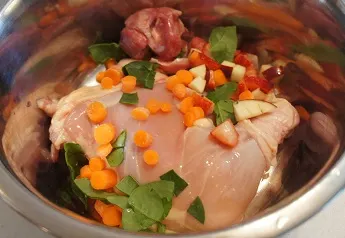
For example, dogs have strong jaws designed for crunching up chunks of meat and bone. They have sharp teeth for slicing into the meat, and their digestive systems are shorter than ours which allows them to handle the extra bacteria without issues. Here is a good article about canine digestive systems.
Dogs can do fine on a cooked, dry dog food or canned diet, but those of us who choose to feed our dogs raw believe it is the healthiest and most natural way for them to eat.
More information:
Why I feed my dogs raw (from That Mutt’s writer, Barbara)
Why can’t you just cook the meat for your dog?
You can, but why would you?
Raw meat and raw vegetables are healthier for most dogs than cooked food because cooking destroys the enzymes needed for superior digestion and nutrient absorption. These enzymes survive the freezing/defrosting process just fine.
Remember, dogs ate raw meat for thousands of years before “dog food” was invented.
How much raw food should I feed my dog?
The general rule of thumb is to feed roughly 2 to 3% of your dog’s ideal body weight per day.
However, this is only an ESTIMATE. Some dogs require more calories, especially puppies or highly active dogs.

My own dog is on the extreme side of needing calories due to our training for ultramarathons.
We typically run about 25 miles per week. He is a 2.5-year-old male Weimaraner who is naturally lean at 63 pounds. He requires 4% of his body weight in food per day (2.5 pounds) to maintain his weight. On our longer running days I give him 5% (3 pounds).
Your dog’s weight in ounces.
Since most of us will be weighing our dog’s food in ounces, sometimes it helps to know how many ounces your dog needs per day vs. pounds. My dog needs 40 ounces per day.
Just take your dog’s weight in pounds and multiply it by 16 to get their weight in ounces. Then take 3% of that to get an estimated amount of how many ounces your dog needs per day. (Example: 63 x 16 = 1008 ounces. Multiply that by .03 to get the daily amount, which is 30 ounces.)
More info:
How much raw food to feed my dog
What is the cost of feeding raw dog food?
Feeding your dog a raw diet is definitely an investment. I would say for a 65 pound dogs the average cost for pre-made raw is $250 to $300 per month.
When you feed homemade raw, you can cut the cost dramatically. I still spend about $150 per month when I make homemade raw (63 pound dog), but you can really put in the effort to buy in bulk and get great deals to bring your cost down. Some people spend the same amount on raw as they would on dry; you just have to get creative.
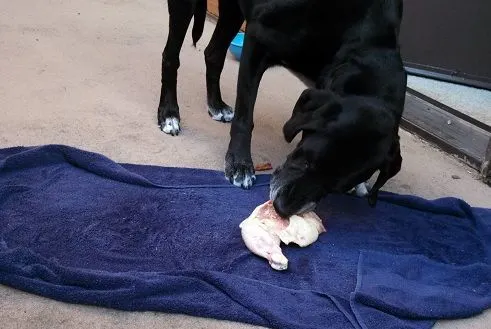
Of course, the investment of feeding raw will hopefully mean fewer vet bills, an increased quality of life, fewer health issues in general and a longer length of life. No guarantees but improving your dog’s diet is one thing you have full control over.
Further reading:
Start with a pre-made raw dog food brand
When you first feed your dog a raw diet, I highly recommend you start with a pre-made raw brand such as Darwin’s. Frozen raw food is the easiest way to go, and I recommend you order at least two week’s worth and go from there.
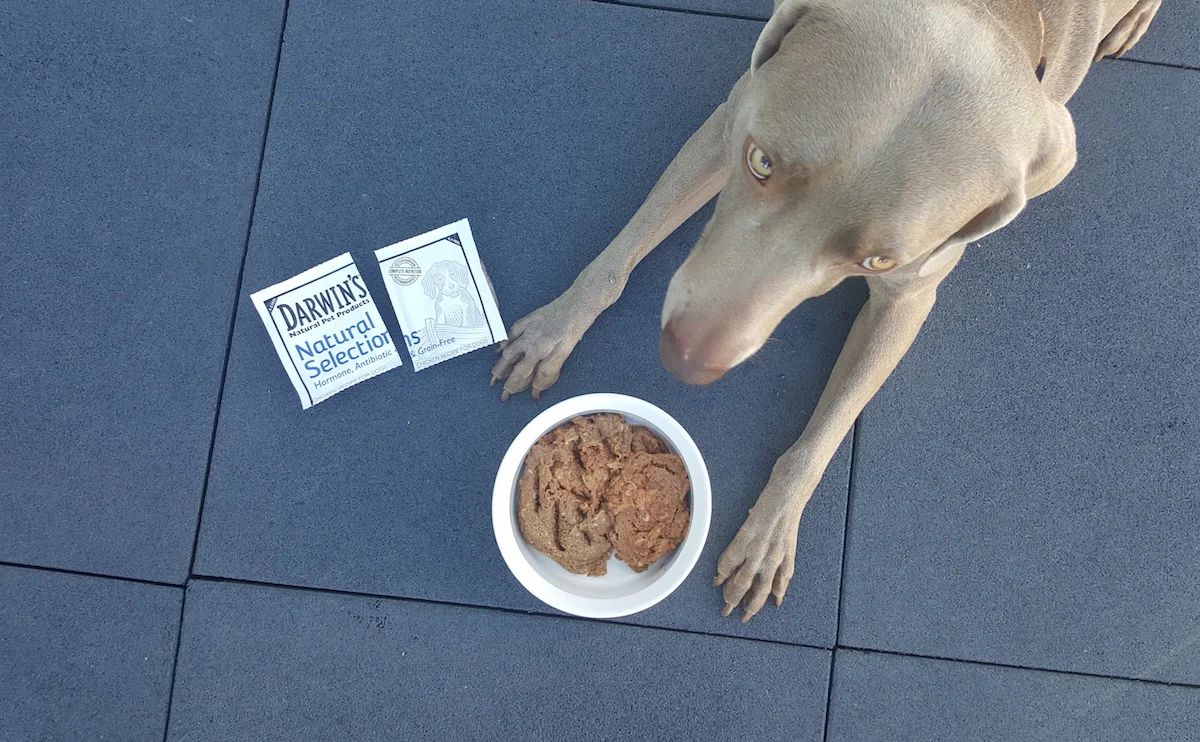
I recommend beginners start with a pre-made raw dog food brand because of:
Convenience. Feeding a raw diet seems very complicated to beginners and the largest barrier is people worry it’s too difficult. Most dog owners just go back to feeding dry food for this reason. You are paying for convenience, and that is worth it!
No worries about balance. The food is balanced, period. No worries about harming your dog or doing something wrong. No need to add supplements.
Bones are ground. Eventually you may want to feed your dog raw meaty bones because there are benefits to this. However, bones are scary to beginners. Feeding the bones ground in the food is the easiest way to get started.
Feed your dog the pre-made brand for six weeks to help yourself get used to feeding raw. You’ll see how your dog responds, you’ll learn how much to feed, etc.
Yes, this is an investment. Depending on the size of your dog, it might cost $200 to $300 to feed raw dog food for one month. (Yay if you have a smaller dog!).
Benefits of Darwin’s raw dog food
My favorite pre-made raw dog food brand is Darwin’s Natural Pet Products. I reached out to them about partnering together because I want to recommend their brand to my readers regularly. Darwin’s is a sponsor of That Mutt.
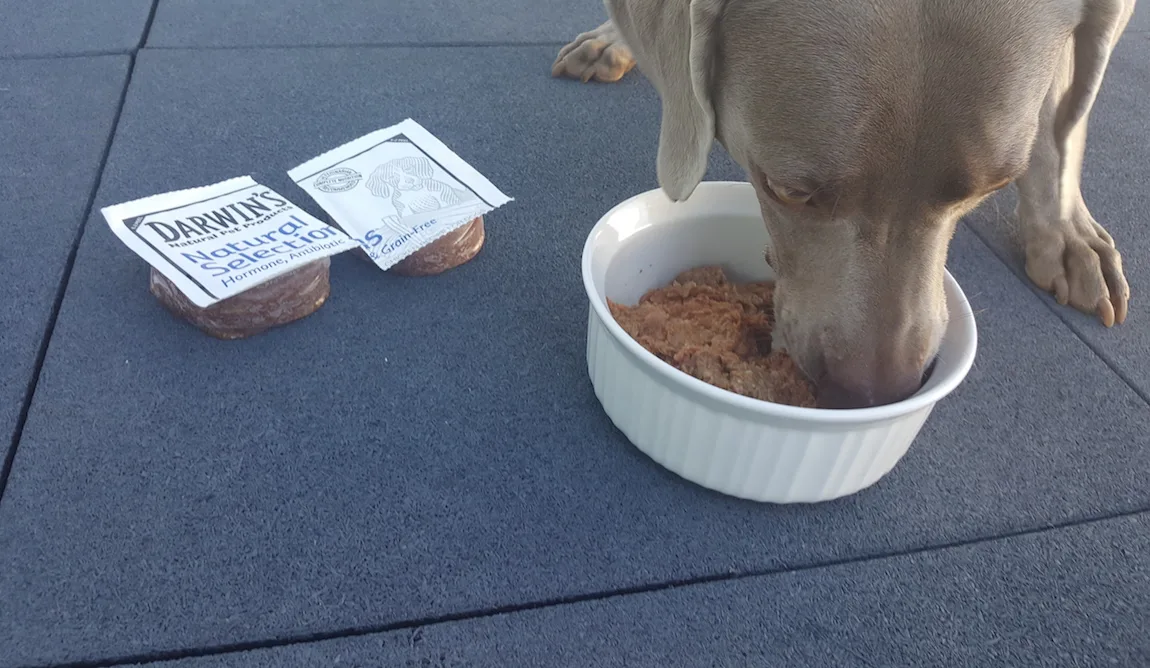
Right now, Darwin’s has an awesome trial offer going on. You can get 10 pounds of food for just $14.95! No code required. Click here.
Reasons Darwin’s is my favorite brand:
- Darwin’s delivers to your door every two weeks (or you can make a custom delivery plan)
- The company has an organic line and a more economical line
- Darwin’s is conveniently portioned in 8-ounce pouches that are easy to open
- They have a trial offer for new customers
Making your own raw dog food
Once you’ve been feeding your dog a pre-made brand for a month or two, you should be feeling comfortable with the concept of raw feeding. You’ll no longer be worried about your dog getting sick from the raw meat, for example. And, you’ll have a pretty good idea of how much food your dog needs to eat per day.
The healthiest way for most of us to feed a raw diet is to continue with a pre-made brand. This way, you know the food is balanced.
However, the cost is an issue for many dog owners, so the next best thing is to feed a combination of pre-made raw and homemade raw.
What to include in a homemade raw dog food diet
Rather than making balanced “recipes” right away, I would focus on introducing your dog to one type of protein such as raw chicken. You could feed some boneless meat such as chicken thighs as well as some chicken with bone such as chicken quarters.

*Get this post emailed as a pdf. Read it later at your convenience. Click Here
Once your dog seems to be doing OK with raw chicken, you could slowly add in some organ meat and another protein such as pork or beef. One of the most common mistakes is people add too many new foods too quickly because they’re trying to “balance” the meals and add variety. Don’t worry about “balance” right away.
Common foods to include in a dog’s homemade raw diet: Ground beef, chicken thighs, chicken quarters, chicken wings (small dogs), chicken necks (small dogs), turkey thighs, turkey necks, raw pork, raw eggs, beef or chicken liver, chicken or turkey gizzards.
Eventually, you’ll want to follow the general “rule” of 80% muscle meat, 10% bone and 10% organ meat. This does not have to be on a daily basis but averaged out over the week.
More info:
Homemade raw dog food recipes
Where to buy organ meat
Organ meat is the most challenging piece to feeding a balanced raw diet because it’s harder to find, depending on where you live. I can always find chicken liver at my grocery store but liver should only be half of your dog’s organ meat.

Definitely check around at the various grocery stores in your region, including Costco and Wal-Mart. You can also look into “ethnic” grocery stores to see if they carry organ meat such as kidneys.
More info:
Where to buy organ meat
Are raw bones safe for dogs?
Raw bones are an important piece of a dog’s balanced raw diet (roughly 10% of the dog’s diet).
I personally only feed raw chicken and raw turkey bones because they are softer and smaller than raw beef and pork bones making them easy for dogs to digest. I only feed raw beef bones if they are ground in with the meat (from Darwin’s).
Raw bones I suggest you start with include raw chicken thighs, chicken quarters or turkey necks. These are all considered “raw meaty bones” simply because they are raw bones with the meat still on them.
For smaller dogs, you can try chicken wings or necks but these could be a (slight) choking risk fo larger dogs.
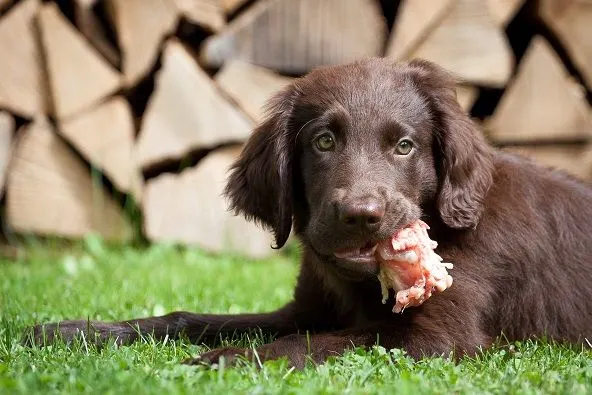
Don’t worry if your dog swallows large chunks of meat and bone. They have highly acidic stomachs designed for handling the raw meat and bones.
My 63-pound dog crunches up a chicken thigh for about 4 seconds and then swallows it. No big deal!
To slow your dog down, you can feed the food slightly frozen if you’d like. That’s what I do for my food hound.
More info on feeding raw bones:
Which raw bones are safe for dogs?
Why is dry dog food kibble bad for a dog?
I do not have to be a vet or a nutritionist to realize that most commercial dog foods are not ideal for Remy. Please read the ingredients of your dog’s food and let me know what you find out.
It is not bad to feed your dog a dry diet. Just read the ingredients and choose the best quality food within your budget.
The first two ingredients in a dog’s food should be high-quality proteins, according to Michelle Smith, owner of Natural Pet Center in Fargo, which sells natural dog food and other pet products.
These should be specific proteins like duck or chicken. Other ingredients should be high-quality fruits and vegetables. Grain is not necessary, and all corn and by-products should be avoided.
When an animal goes to a slaughterhouse, only about half of that animal is used in human foods, according to Born Free USA, a national animal advocacy organization.
These “other parts” (heads, feet, blood, unborn babies, etc.) are considered by-products and are used in pet foods.
“Meat meal,” “poultry meal” and “by-product meal” are also common ingredients in pet foods, according to Born Free. The term “meal” means the ingredients have been rendered.

Rendered ingredients
Rendering plants take all the random, leftover body parts and boil them down to a broth. Although the high temperatures kill bacteria and parasites, the natural enzymes and proteins found in raw ingredients are also destroyed.
Many pet foods also contain brewers rice as the first or second ingredient, which is an inexpensive rice by-product that contains no nutritional value, according to the Association of American Feed Control Officials.
The AAFCO sets unenforced standards for the quality of livestock feed and pet food.
If you do decide to feed your dog rice (most dogs don’t need grain in their diets), make sure it’s whole grain brown rice.
Commercial dry dog food sometimes contains chemical preservatives, sweeteners and dyes. None of these ingredients provide any nutritional value to a dog.
They are used to improve the taste and appearance of the food. Potentially cancer causing chemicals such as BHA, BHT and ethoxyquin are permitted in pet foods as preservatives.
If you choose to feed your dog a dry food, I recommend Wellness CORE because I trust the company and the ingredients. I sometimes have a bag on hand for Remy in case I run out of his raw food.
Do you have a question on raw feeding?
Let me know in the comments!
*Get our three FREE raw dog food recipes now! Click Here
Additional Resources:
See all of our raw feeding articles HERE.
Lindsay Stordahl is the founder of That Mutt. She writes about dog training, dog exercise and feeding a healthy raw diet.

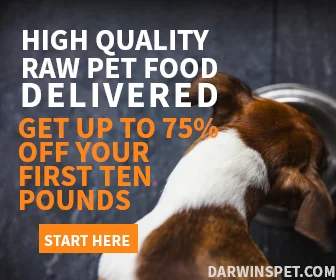
Joanna
Friday 28th of October 2022
Hello my puppy is 8 months old and today I tried to start of with the raw food diet. I gave him ground beef, a chicken leg, 2 chicken feet and 2 small gizzards. He ate the ground beef but was very hesitant on the other stuff. He threw up a few minutes after and it was the ground beef. What should I do? How should I start him off?
Alexis DeCaprio
Wednesday 1st of June 2022
I have tried several recipes and my dog is not able to process carbs even with high quality enzymes but gets constipated on meat only. Any suggestions?
Alexis DeCaprio
Thursday 2nd of June 2022
@Lindsay Stordahl, 2oz of beef liver about every other day. Definitely not too much bones they are given very rarely because his teeth aren’t in great shape. I usually just give him eggs with the shell for calcium. His bowel movements are not crumbly at all, like I’ve seen with too much bone, they are just small and not as often as he does with vegetables and fruit.
Lindsay Stordahl
Thursday 2nd of June 2022
Are you adding organ meat to the mix? Or perhaps too much bone?
Mawget
Saturday 28th of May 2022
Very afraid of them getting sick , our dogs get sick if we just change brands of food , even tho we work it in slowly very small amounts and work up to more ???
Janet
Wednesday 6th of January 2021
I have fed my dogs (4lb & 6.5lbs) raw for about 4yrs now I have recently started having “meat” days and “plant” day. I understand that their system digest “plants” quicker than meat, therefore leaving the “plants” to ferment causing stomach issues (etc. gas). They seem to be doing well on it and they ❤️ the veges “plants”.
Jacquelinekozy
Wednesday 2nd of December 2020
I have a shepherd mix and he has been on the raw food diet for about 4 months. I recently started adding some cooked potatoes, cooked carrots. I mix it up during the week. My concern now is he doesn't want to eat. He'll walk over to his food , sniff it then walk away. Just started about 1 day ago. He gets fed at 9:30 am then again at 5:30 pm. Should I remove the veggies and potatoes and see what he does? I thought maybe he didn't like it anymore... TIA..